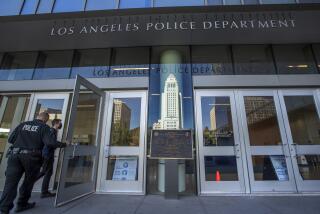Taser trainer testifies in Oakland BART slaying trial
- Share via
A former transit officer on trial in the fatal shooting of a passenger at an Oakland BART station received six hours of training on the use of a Taser, the state minimum, a defense witness testified Wednesday.
The official also testified that then-Officer Johannes Mehserle was warned of the dangers of confusing his handgun with his Taser — which is what Mehserle’s lawyers insist happened in the New Year’s Day 2009 shooting at the Fruitvale transit platform.
FOR THE RECORD:
BART murder trial: A June 24 story in the LATExtra section about the trial of a former BART transit officer charged with murder in the shooting of an unarmed man identified the victim, Oscar J. Grant III, as being 26. He was 22. —
Officer Stewart Lehman, who conducted Taser training for the Bay Area Rapid Transit police, told jurors that Mehserle received a couple of hours of hands-on experience but was able to discharge a Taser only on a limited basis.
Mehserle, who is white, has pleaded not guilty in the slaying of Oscar Grant III, a 26-year-old African American from Hayward. The case is being heard in Los Angeles because of pre-trial publicity in the Bay Area.
Lehman testified that the department restricted the number of discharges during training because the cartridges are costly. He added that BART did not have a Taser for each officer in the training session, and that officers received the minimum number of training hours required by the state.
“You can always increase the number of hours of training,” Lehman told jurors.
During the training, Mehserle was shown four positions on his belt and leg approved for carrying the Taser to avoid confusion with his handgun, Lehman testified. Mehserle, who is right-handed, used the department-approved method of placing the device on the left side of his belt for a cross-over draw. The gun-shaped Taser fires electrodes that cause disabling muscle spasms.
Michael L. Rains, Mehserle’s attorney, questioned Lehman about three incidents in 2001 and 2002 in Sacramento, Madera, Calif., and Minnesota in which officers fired their guns when they intended to discharge the less lethal Taser. In the Madera case, an officer fatally shot a man inside a police car.
But Alameda County Deputy Dist. Atty. David R. Stein got Lehman to demonstrate how drawing a Taser, such as the bright-yellow one carried by Mehserle, was different from drawing a handgun, and to explain that officers are required to announce, “Taser, Taser, Taser,” to alert colleagues to its use.
Stein also got Mehserle’s partner, Jon Woffinden, to acknowledge that the defendant never told him it was an accident after the shooting occurred.
Prosecutors have sought to show that Mehserle never told fellow officers it was a mistake, and have argued that the shooting was the culmination of a chaotic scene.
More to Read
Sign up for Essential California
The most important California stories and recommendations in your inbox every morning.
You may occasionally receive promotional content from the Los Angeles Times.











